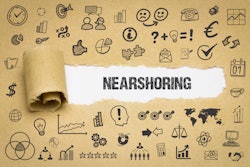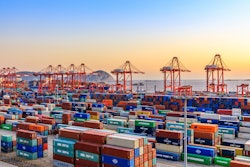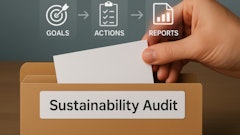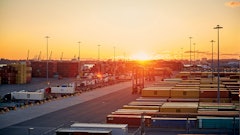
One news headline. One tariff announcement. One policy shift. That’s all it takes to throw global supply chains into a tailspin. But as shippers scramble to keep up with this volatility, they risk making a big mistake: sidelining sustainability.
In today’s uncertain transportation environment, tariffs, geopolitical instability, and inflationary pressures are forcing supply chain leaders to adjust strategies on the fly. Regulatory shifts add another layer of complexity, with federal sustainability standards facing legal and political headwinds, even as states like California and New Mexico push forward with more ambitious climate policies.
While it’s tempting to focus solely on immediate survival, doing so puts long-term resilience at risk. By staying the course on sustainability — rather than reacting to short-term disruptions — you will be better positioned to build resilient transportation networks and lead through future volatility.
Short-term thinking has long-term consequences
The cost pressures shippers face today go beyond just tariffs. Amid recession fears, higher interest rates, and fluctuating fuel prices, it’s natural for organizations to focus on bottom-line performance. However, deprioritizing sustainability is a strategic oversight.
Though climate standards are currently encountering legal and political roadblocks at the national level, many states are pursuing their own initiatives, despite federal resistance. If you lose momentum on sustainability now, you risk falling behind when this next wave of regulations arrives.
For instance, the California Air Resources Board (CARB) approved updates to the state’s Low Carbon Fuel Standard, introducing more aggressive targets to reduce the carbon intensity of transportation fuels and expand support for clean energy infrastructure. Meanwhile, New Mexico has adopted a Clean Transportation Fuel Standard that will require fuel suppliers to reduce the emissions profile of their products, with the program expected to take effect in 2026.
A recent Executive Order tasked the U.S. attorney general with finding ways to stop enforcement of state-run climate programs, throwing these initiatives’ fates into question. However, the governors of California and New Mexico — along with the governors of 40 other states — have vowed to fight the EO. In other words: The regulatory pendulum is still in motion, and it would be a mistake to assume it will never swing back.
Moreover, delaying investments in sustainability leaves operations exposed to rising costs, limited capacity, and growing compliance burdens, making it harder to adapt as market and regulatory pressures intensify. And with alternative energy equipment costs anticipated to rise due to tariffs, it will take careful planning and decisive decision-making to mitigate cost impacts.
The takeaway? No matter what’s happening in the market today, you must remain focused on building transportation networks that are agile, efficient, and cost effective.
Turn sustainability into a strategic advantage
There’s a common misconception that prioritizing sustainability requires significant financial investment. In reality, many sustainability initiatives can go hand-in-hand with cost efficiency by supporting optimized shipping operations.
To keep your sustainability initiatives on track, consider these three tips:
- Take advantage of strategic opportunities.
Look for opportunities that deliver immediate cost savings while helping you progress toward sustainability goals. For instance, unused capacity accounts for roughly 12% of freight emissions. By optimizing load fill, you could reduce your carbon footprint and unlock cost savings.
Optimizing routes amplifies these benefits, further reducing transportation costs and decreasing overall mileage. Over time, these kinds of incremental improvements compound to build a more efficient and sustainable network.
2. Strengthen your data-driven decision-making.
Market volatility and regulatory shifts aren’t going away, which is why it’s critical to avoid knee-jerk reactions and leverage market expertise from a trusted, strategic transportation partner. Equip your teams with technology and clean and comprehensive data that enables them to proactively evaluate and adapt to market and regulatory changes.
Monitoring macro trends like tightening clean fuel standards and shifting global trade policies gives you critical context to inform your long-term strategy. In addition, platforms that provide a view of your network against the industry, monitor emissions, and model lane-level scenarios enable you to pinpoint opportunities that drive both short-term gains and long-term growth.
For example, by tracking load-level emissions data across your network, you can identify high-impact, low-lift opportunities to switch to more efficient carriers or shift to more efficient transportation modes, reducing emissions and costs without compromising service levels. With real-time visibility into transportation network data and adaptive processes in place, you can make proactive, strategic decisions in the face of disruption.
3. Lean into strategic partnerships.
Relationships with carriers, logistics providers, and suppliers should support mutual success — not just cost containment. Yet only 14% of shippers include alternative energy requirements in RFIs and RFPs, which is a missed opportunity to align on emissions goals from the start.
The RFP is a critical point to embed sustainability priorities into your strategy and gather insights that will shape your partnerships. If you’re early in your sustainability journey, start by requesting detailed carrier sustainability data during RFI processes to establish a baseline. This data could include emissions reduction initiatives, alternative fuel adoption, or fuel efficiency enhancements.
As you progress, introduce sustainability criteria into your evaluations and begin to prioritize carriers that invest in alternative energy, newer trucks that have a higher fuel efficiency, or other initiatives that align with your broader sustainability and operational goals.
Beyond the RFP, collaborate with strategic transportation partners to identify mutually beneficial opportunities — such as optimizing fuel efficiency, exploring intermodal transportation options, or piloting emerging alternative energy options available in your network.
Staying the course on sustainability: The key to lasting resilience
Sustainability doesn’t exist in a vacuum — it’s closely linked to operational efficiency, cost control, and agility. By identifying and implementing small changes that have a big impact, you can reduce risk, stay ahead of evolving legislation, and build transportation networks that are both prepared for disruption and positioned to grow.
In an environment shaped by constant change, shippers that champion sustainability as a core pillar of their transportation strategies will be the ones who lead, adapt, and thrive.


















